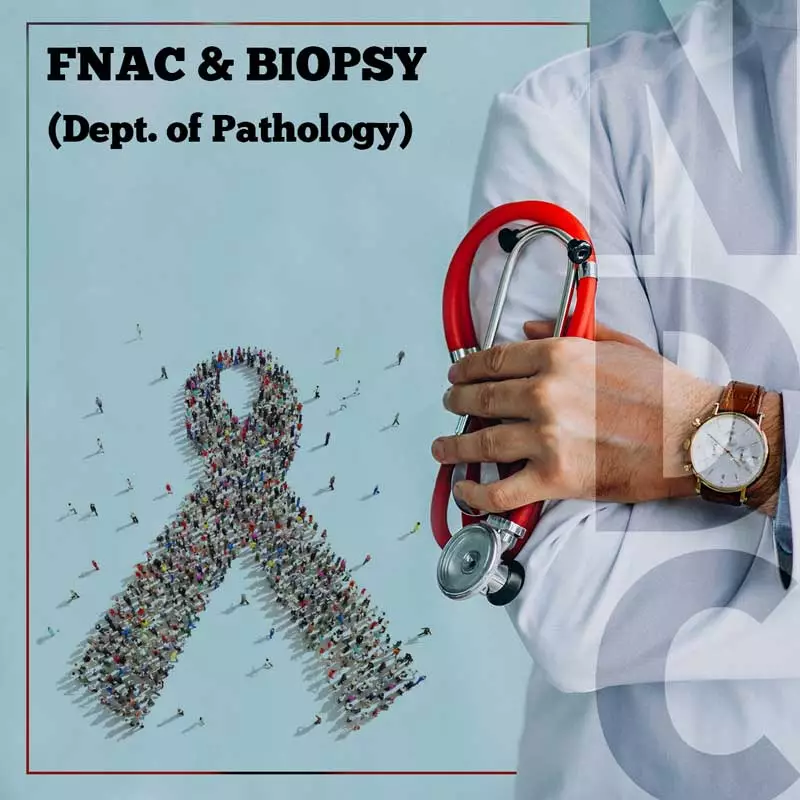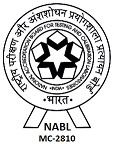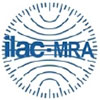FNAC & Biopsy

FNAC & Biopsy are diagnostic procedures to determine cancerous presence.
When a lump, or a bump is discovered in superficial areas of the body such as the breast, neck, axilla FNAC is recommended to determine whether the lump is cancer. This procedure is also used to test for thyroid, salivary glands, and lymph nodes illnesses.
During a biopsy, a doctor removes a small amount of tissue from the affected part of your body to examine under a microscope.
Biopsy
Biopsy is recommended if the doctor finds something suspicious during a physical exam or other tests. A biopsy is the main way doctors diagnose most types of cancer. Other tests can suggest that cancer is present, but only a biopsy can make a diagnosis.
During a biopsy, a doctor removes a small amount of tissue to examine under a microscope. Sometimes surgery or another procedure may be needed to get a tissue sample. The type of biopsy you receive depends on where the possible tumor is located.
Image Guided Biopsy:
The doctor may use an image-guided biopsy approach when he or she cannot feel a tumor or when the area is deeper inside the body. During this procedure, at North City Diagnostic Centre, the doctor guides a needle to the location with the help of an imaging technique. The doctor can do an image-guided biopsy using a fine needle or core biopsy (see below). This depends on the amount of tissue needed, possible diagnoses, and other factors. The doctor here will use one of the following types of imaging based on the location and other factors:
- Ultrasound
- Fluoroscopy
- CT Scan
- X-Ray
- MRI Scan
Fine Needle Aspiration Biopsy
During this minimally invasive biopsy, the doctor uses a very thin, hollow needle attached to a syringe. He or she collects a small amount of tissue from the suspicious area to examine and test. Your doctor may use this biopsy for a mass that he or she can feel through the skin or with image-guided biopsy (see above).
Core Needle Biopsy
This type of biopsy uses a larger needle to remove a larger tissue sample. It is similar to a fine needle biopsy and is also minimally invasive.
Excisional Biopsy
During an excisional biopsy, your doctor removes the entire suspicious area. This is commonly used for suspicious changes on the skin. Doctors also sometimes use it for a small, easily removable lump under the skin. However, fine needle aspiration or core needle biopsy are more common for lumps that cannot be seen or felt through the skin.
Getting ready for a biopsy
Preparation for a biopsy depends on the type of biopsy you will have. For example, there is little preparation for a fine needle biopsy performed in a doctor’s office. In some cases, you will need to remove your clothing and wear a gown.
Before your biopsy:
Ask our health care team whether you can eat or drink anything before the biopsy.
Also, ask if you should take your regular medications that day. For certain biopsies, the doctor will want to know if you are taking blood thinners or aspirin. Tell the doctor about all medications and supplements you are taking.
Tell the doctor about any drug allergies or other medical conditions you may have.
A member of our health care team will explain the procedure to you.
You will be asked to sign a consent form that states you understand the benefits and risks of the biopsy and agree to have the test done.
Talk with your doctor about any concerns you have.
During the procedure
Depending on the part of your body the doctor will biopsy, you may lay on your stomach or back or sit up during the procedure. For some types of biopsies, you may need to hold your breath while the needle is inserted or stay still. Our health care team, at North City Diagnostic Centre, will let you know ahead of time what to expect during the procedure.
Before the procedure, you will usually receive a type of anesthesia to block the awareness of pain. The type of anesthesia the doctor uses depends on the type of procedure and wherein the body the biopsy is needed. The following types may be used:
Local anesthesia is an injection that numbs the area where a procedure is being done. You may feel some stinging when the doctor injects a local anesthetic with the needle.
Conscious sedation or monitored anesthesia care uses medication to relax you. It is usually given through an intravenous (IV) tube and is often combined with local or regional anesthesia.
General anesthesia makes you unconscious during a major procedure, such as surgery. If you receive a general anesthetic, you will not be aware of the procedure.
After the procedure
Your recovery period depends on the type of biopsy:
The least invasive procedures require no recovery time. You may be able to go back to your normal activities immediately after the procedure.
More invasive procedures may require a longer recovery time.
After a biopsy, talk with your doctor or nurse about taking care of the biopsy area. Also, be aware of the potential complications from the procedure. Contact the doctor if you experience:
Infection
Severe pain
Fever
Bleeding
Getting your results
The amount of time it will take for you to receive the results of the biopsy depends on how many tests are needed on the sample to make a diagnosis. Based on this analysis, a pathologist determines whether the tissue removed contains a tumor and what type it is.
FNAC
Fine Needle Aspiration Cytology (FNAC) is a simple, quick, and inexpensive method that is used to sample superficial masses like those found in the neck and is usually performed in the outpatient clinic. The procedure is minimally traumatic to patients and virtually free of complications. Through this technique, mass lesions in the neck and head, including lesions in the salivary gland and thyroid gland, can be easily diagnosed.
FNAC is considered to be the most accurate and cost-effective procedure, especially if ultrasound is used as a guide to help collect tissues from cystic lesions.
During the FNA, patients are awake and alert. Local anesthesia is used to numb the area into which the needle is inserted.
FNAC is generally considered a painless procedure with most patients reporting only mild to no pain during the procedure.
They should not be taken on an empty stomach. Patients can then return to their normal routines after the test.
- No aspirin or non-steroidal anti-inflammatory medications (e.g., ibuprofen, naproxen) for one week before the procedure
- No food a few hours before the procedure
- Routine blood tests (including clotting profile) must be completed two weeks before the biopsy.
- Suspension of anticoagulants (blood thinners)
- Antibiotic prophylaxis may be instituted.




